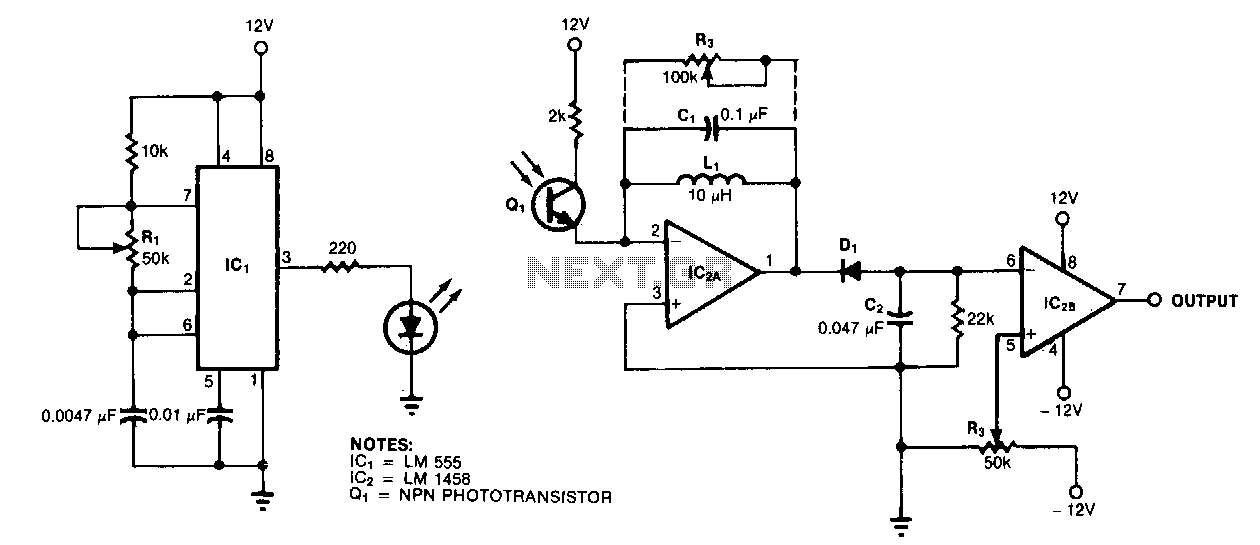
Ambient-light-ignoring-sensor

A resonance-tuned narrow-band amplifier enhances the optical object detector's resistance to stray light. The components C1 and L1 within the feedback loop of IC2A enable the operational amplifier to transmit only those frequencies that are at or near the LED's 5-kHz modulation rate. Additionally, the output of IC2B rises when the received signal is strong enough to reduce the negative voltage across C2 below the reference level established by R2.
The circuit employs a resonance-tuned narrow-band amplifier configuration to effectively filter out unwanted stray light interference in optical object detection applications. The operational amplifier IC2A is designed with a feedback loop that incorporates a capacitor (C1) and an inductor (L1). This configuration creates a resonant circuit that selectively amplifies signals at the specific frequency of interest, which is the 5-kHz modulation rate of the LED. By doing so, the amplifier significantly enhances the signal-to-noise ratio, allowing for more accurate detection of the intended optical signals while minimizing the effects of ambient light.
IC2B serves as a subsequent stage in the detection process, where its output is contingent upon the strength of the received optical signal. When the incoming signal is sufficiently strong, it causes the voltage across capacitor C2 to drop below a predetermined reference level set by resistor R2. This condition triggers an increase in the output of IC2B, indicating that the signal has surpassed the threshold necessary for detection. The interaction between these components is crucial for maintaining the integrity of the detection process, ensuring that only relevant signals are processed and that the system remains responsive to changes in the detected optical environment.
Overall, this circuit design exemplifies the principles of resonance tuning and signal processing in electronic amplifiers, showcasing its application in enhancing the performance of optical detection systems.A resonance-tuned narrow-band amplifier reduces this optical object detector"s sensitivity to stray light. C1 and L1 in IC2A"s feedback loop cause tbe op amp to pass only those frequencies at or near the LED"s 5-kHz modulation rate.
IC2B"s output increases when the received signal is sufficient to drop the negative voltage across C2 below the reference set by R2. 🔗 External reference
The circuit employs a resonance-tuned narrow-band amplifier configuration to effectively filter out unwanted stray light interference in optical object detection applications. The operational amplifier IC2A is designed with a feedback loop that incorporates a capacitor (C1) and an inductor (L1). This configuration creates a resonant circuit that selectively amplifies signals at the specific frequency of interest, which is the 5-kHz modulation rate of the LED. By doing so, the amplifier significantly enhances the signal-to-noise ratio, allowing for more accurate detection of the intended optical signals while minimizing the effects of ambient light.
IC2B serves as a subsequent stage in the detection process, where its output is contingent upon the strength of the received optical signal. When the incoming signal is sufficiently strong, it causes the voltage across capacitor C2 to drop below a predetermined reference level set by resistor R2. This condition triggers an increase in the output of IC2B, indicating that the signal has surpassed the threshold necessary for detection. The interaction between these components is crucial for maintaining the integrity of the detection process, ensuring that only relevant signals are processed and that the system remains responsive to changes in the detected optical environment.
Overall, this circuit design exemplifies the principles of resonance tuning and signal processing in electronic amplifiers, showcasing its application in enhancing the performance of optical detection systems.A resonance-tuned narrow-band amplifier reduces this optical object detector"s sensitivity to stray light. C1 and L1 in IC2A"s feedback loop cause tbe op amp to pass only those frequencies at or near the LED"s 5-kHz modulation rate.
IC2B"s output increases when the received signal is sufficient to drop the negative voltage across C2 below the reference set by R2. 🔗 External reference